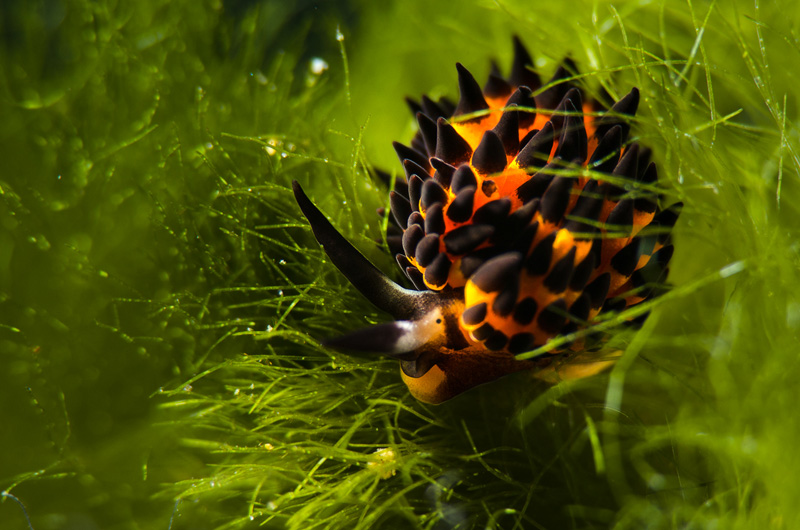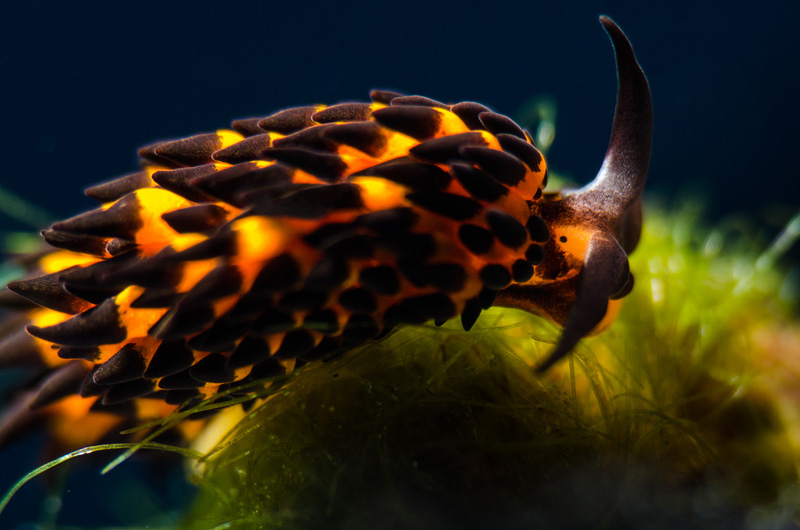The Southern California coast has been experiencing some unusually high ocean temperatures and with it some very unusual marine life. Fishermen have reported catching Blue Marlin, Mahi Mahi and Yellowfin Tuna as far north as Oxnard. Reports of Hammerhead sharks visiting the waters of San Diego have been accompanied by numerous images taken by local photographers. We have even seen news reports of a Whale shark in the waters near Catalina Island, and most recently Sperm whales near Dana Point. It is believed that all these marvelous creatures have been attracted by the “El Nino” conditions the California coast is experiencing.
Photos and Story by Brook Peterson
I was lamenting the fact that I had not personally seen any of these exotic animals, despite spending hours and hours diving in coastal waters. This put me in a somewhat spiteful mood, so before I boarded the dive boat , I set my camera up for macro and prayed that Murphy wouldn’t enact his law on me. What a great choice that turned out to be!
My first two dives of the day were average, in that I found a few macro critters to photograph, but nothing new or unusual. On the third dive I was looking hard for tiny isopods or skeleton shrimp in the algae growing on the sides of boulders when I saw a tiny spot of orange in the green algae. I had to use the magnification of my camera lens to see it properly and quickly determined that it was a nudibranch that I had never seen before. I knew I had something special to photograph, so I spent the rest of my dive trying to keep the tiny creature in front of my lens.
When I arrived back on the mainland I arranged for one of my images to be sent to some authorities in Marine Science. Ángel A. Valdés, Ph.D., Department of Biological Sciences, California State Polytechnic University responded, that based on the photograph, the slug appears to be Placida cremoniana, a sacoglossan sea slug. He amended that further research would be necessary to verify this find, as this is the first time it has been recorded this far north, and we don’t know if this is a species complex, or a species that has dispersed recently (human introduction).
Jeffrey Goddard, Ph.D., Marine Science Institute, University of California Santa Barbara said, “In the eastern Pacific Placida cremoniana (an aeolid-like sacoglossan sea slug, rather than a nudibranch) has been recorded previously only from La Paz, Baja California Sur south to Costa Rica. Globally it is widespread in warm waters, and known from the western Pacific, Hawaii, the Mediterranean Sea, and more recently, Florida. Placida cremoniana feeds suctorially on green algae with large cells, including species of Derbesia.” David W. Behrens, co-author of Eastern Pacific Nudibranchs A Guide to the Opisthobranchs from Alaska to Central America also responded, saying the slug has indeed been found in Mexico and an identification can be found on page 46 of his book.
Although it resembles an aeolid nudibranch, this sea slug has rolled rhinophores which identify it as a socoglossid. Most socoglossids feed on green algae, and are green in color as a result. While P. cremoniana feeds on green algae, it retains its bright orange color, with black tipped cerata and black rhinophores. It is very tiny, like most socoglossids, with adults measuring up to 8mm.
I can’t help wondering, how did something so tiny survive a journey all the way across the Pacific to take up residence at Catalina Island? Is it alone or does it have siblings? Perhaps its survival is a result of the warmer water temperatures. It is remarkable to think that just a few degrees Farenheit can have such a broad effect on marine life, from a creature as large as a sperm whale to one as small as a sea slug.
———
Photos and Story by Brook Peterson
All content above ©2014 by the original author and may not be reposted, repurposed, or used without prior express written permission.



